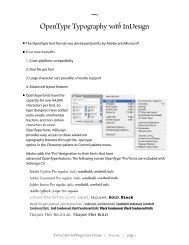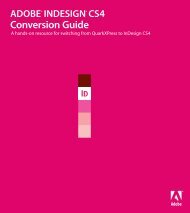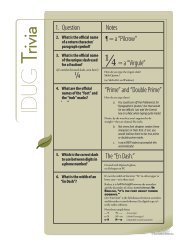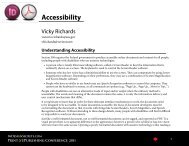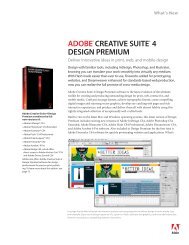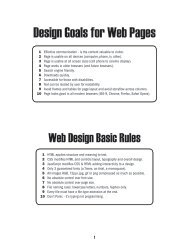Quark to InDesignCS3 Conversion Guide - InDesign User Group
Quark to InDesignCS3 Conversion Guide - InDesign User Group
Quark to InDesignCS3 Conversion Guide - InDesign User Group
You also want an ePaper? Increase the reach of your titles
YUMPU automatically turns print PDFs into web optimized ePapers that Google loves.
Isolate blending. When you apply<br />
blending modes <strong>to</strong> objects in a<br />
group, the blending modes affect<br />
other objects in the group as well<br />
as objects beneath the group. If<br />
you select Isolate Blending in<br />
the Effects panel, only objects in<br />
the selected group are affected<br />
by blending modes applied <strong>to</strong><br />
objects within the group. Objects<br />
beneath the group are unaffected.<br />
Displaying transparency. The controls<br />
in the Display Performance<br />
pane of the Preferences dialog box<br />
(<strong>InDesign</strong> > Preferences > Display<br />
Performance in Mac OS or Edit ><br />
Preferences > Display Performance<br />
in Windows) let you set display<br />
options for raster images, vec<strong>to</strong>r<br />
graphics, and transparency. If you<br />
set the Transparency slider <strong>to</strong> Off<br />
(by moving the slider all the way <strong>to</strong><br />
the left), transparency effects are not<br />
displayed onscreen but are maintained<br />
when you print or export the<br />
document. The other three slider<br />
settings—Low Quality, Medium<br />
Quality, and High Quality—let you<br />
control the display quality of transparent<br />
objects.<br />
52 Adobe <strong>InDesign</strong> CS3 | <strong>Conversion</strong> guide<br />
You can use the Display Performance<br />
commands (View menu) <strong>to</strong> quickly<br />
change how <strong>InDesign</strong> displays transparency<br />
globally. Choose Fast Display<br />
<strong>to</strong> turn transparency display off.<br />
Choose Typical Display <strong>to</strong> display<br />
low-resolution effects. Choose High<br />
Quality Display <strong>to</strong> display higherresolution<br />
effects. Change the transparency<br />
display performance level<br />
for a selected object by choosing<br />
Object > Display Performance and<br />
selecting an option.<br />
If you choose highlight > transparent<br />
Objects in the flattener Preview panel,<br />
transparent objects are highlighted in red<br />
on document pages and master pages.<br />
Pages panel. Pages with transparent<br />
objects are displayed with a checkerboard<br />
pattern next <strong>to</strong> the page number<br />
in the Pages panel.<br />
Flattener Preview panel. When<br />
you print or export an <strong>InDesign</strong><br />
document that contains transparent<br />
objects, <strong>InDesign</strong> performs a process<br />
called flattening, which converts all<br />
overlapping areas in a stack of<br />
transparent objects in<strong>to</strong> a collection<br />
of opaque vec<strong>to</strong>r and raster objects<br />
that retains the appearance of the<br />
original objects.<br />
The Flattener Preview panel<br />
(Window > Output > Flattener<br />
Preview) helps designers and printers<br />
prevent mistakes, reduce costs,<br />
and ensure the highest quality<br />
printed results by identifying the<br />
objects on a spread <strong>to</strong> which transparency<br />
effects are applied or that<br />
interact with transparent objects.<br />
The Highlight menu in the<br />
Flattener Preview panel provides<br />
several options for displaying specific<br />
instances of transparency, including<br />
Transparent Objects, All Affected<br />
Objects, and Affected Graphics.








